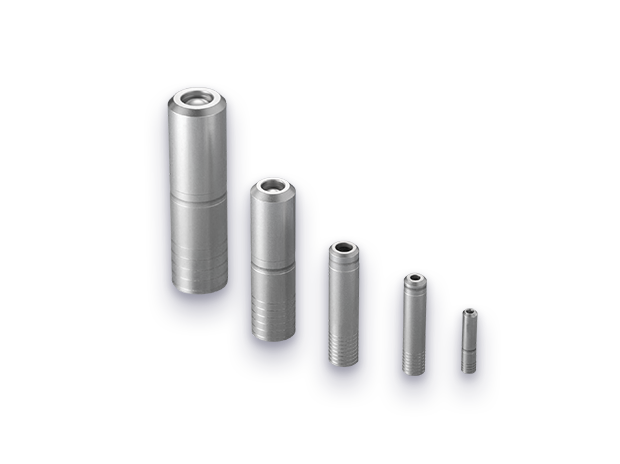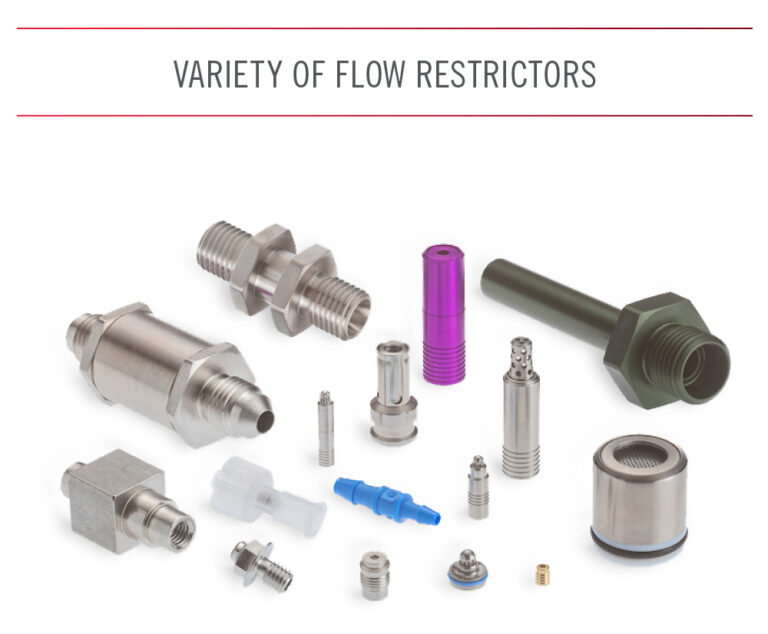
Several factors must be considered to ensure the proper operation of a check valve within a system. Failure to consider these factors may lead to reduced valve or system performance, damage to other components within the system, or a total system failure. The following performance characteristics should be defined when selecting a check valve:
Four pressure ratings should be considered for any check valve: operating pressure, system pressure, proof pressure, and burst pressure. Operating pressure is the pressure applied to the valve during normal operation throughout its life, both in the free flow and checked directions. System pressure is the maximum nominal pressure achieved at the valve’s location within the system. Proof pressure is the pressure the valve can withstand without permanent deformation or degradation of performance when the system returns to operating pressure. Burst pressure is the pressure at which the valve can survive without rupturing or bursting. All four pressure ratings must be considered during design to ensure the valve and its components are sufficiently durable for the application.
To perform its function efficiently, a hydraulic system requires a precise volume of fluid within a specific period of time. For example, an engine requires a specified amount of fuel, and an actuator must extend and retract at a specific rate. A check valve will create an added restriction within the system, so the system designer must specify the necessary flow rate through the valve. The flow rate is typically specified at a point above the cracking pressure when the valve is fully open—also known as the flow point pressure or free flow point. Defining the performance criteria ensures the check valve will have enough capacity to meet system requirements.
Valve leakage can be broken down into two categories: external and internal. External leakage refers to fluid flowing around the exterior of the valve body, which may include threads, O-ring seals, or other external features. Internal leakage is any fluid flow through the valve’s body while the valve is closed, specifically in the checked direction for a check valve. An open or closed system, fluid supply and volume, and desired system efficiency can influence leakage allowances.
A check valve’s opening pressure, or cracking pressure, is the pressure at which the valve opens and begins to allow fluid to pass. The cracking pressure is based on the pressure vessel or system’s design criteria, typically defined as a nominal pressure with a tolerance or maximum. The pressure may be controlled by the spring force used
to bias the valve closed or by the material properties and configuration of a diaphragm. Some check valves include free-floating seals and have zero cracking pressure. Increased cracking pressure is desirable to avoid potential damage caused by fluid flow in the checked direction should external forces, such as a shock or vibration, cause the valve to open despite fluid pressure in the checked direction.
A check valve is comprised of several sub-components. The materials of each component must be able to withstand the various forces that will be applied to them during the valve’s operating life. This includes the internal and external pressures to the valve and the associated pressure rise rates.
Materials must also be compatible with their environment, including external fluids, temperatures, and the system fluid flowing through the check valve. A valve may be subject to extreme humidity or be incorporated into a system submerged in other liquids or gases. The valve’s materials should be considered when determining how the valve will be installed into the system. Failure to consider material compatibility may create thermal expansion and corrosion issues.
The envelope is an essential factor to consider when selecting a check valve. The first consideration is the location of the valve within the system and the desired flow path for the free-flow fluid. The system may require the check valve to be located within a specific area, limiting external dimensions or overall size. The location may also dictate the flow path of the free-flow fluid based on existing lines. The envelope must also account for installation, retention, and maintenance requirements. For example, some valves incorporate threaded tubing ends, while others are installed into manifold housings. Next, determine whether the installation must be permanent or removable. Finally, evaluate if the valve may be used in a system where weight is a factor, such as a portable system.

After determining the required performance characteristics of a check valve, it is critical to identify other variables that will influence the valve’s performance. The internal and external environment of the system will affect the valve’s performance in various ways, impacting every aspect of its functionality and limiting options for the valve’s construction. When designing a valve, the following aspects of the system and environment must be considered:
The performance of a check valve is greatly affected by the operating fluid’s viscosity and specific gravity. Liquids and gases have different fluid properties that impact flow rate, leakage, and the movement of the valve’s internal components. The operating fluid also introduces other variables, such as material compatibility, that must be considered. A fluid incompatible with the valve’s materials could cause damage to the valve, including corrosion or other harmful effects. This damage will negatively affect the performance of the valve and, subsequently, the system. It is also possible that the valve’s materials may alter the fluid’s properties, negatively affecting system performance. For example, a system analyzing blood or chemicals must use inert components for the fluid being analyzed. Similarly, a system flowing a flammable gas may need to avoid metals that may spark when making contact.
It is essential to consider how long the valve must withstand the conditions it will be exposed to during operation. This includes both the maximum length of time the valve shall be in service and the number of cycles the valve performs. A check valve may experience wear due to exposure to its environment or forces caused by contact with internal components, particularly between the sealing components. Excessive wear on the valve’s components over an extended operating life could lead to performance, installation, and retention issues.
Both the temperature of the fluid and the ambient temperature can impact the performance of a check valve. Changes to the temperature of the fluid will alter the fluid’s properties, including viscosity and specific gravity. Liquids will thicken and increase in density with decreases in temperature, making it harder for the fluid to flow. Conversely, increasing temperatures will cause the fluid to thin, lowering its viscosity and density. Leakage rates may increase as temperatures increase because sealing against a thinner fluid is more difficult. Temperatures also impact decisions about the materials used in the check valve. At cold temperatures, some materials become brittle. At elevated temperatures, materials may become soft or melt. These changes can reduce a valve’s operating life. The minimum and maximum temperature rating should be specified for valve performance, normal operation,
and survivability.
Check valve performance is typically based on pressures within the system. However, the check valve envelope may be subject to other environmental pressures, such as deep underwater, underground, or even the absence of pressure in outer space.
Check valves can be subject to forces external to the system in which it is installed, as well as the forces generated by the operation of the system. These forces are typically vibration, shock, and g-force. For example, some systems or vehicles that use check valves generate levels of vibration during normal operation. A shock may occur if the system or vehicle in which the valve is installed suddenly encounters another object. Lastly, the system or vehicle may generate g-forces during operation due to sudden forceful movement. The potential forces’ magnitude, frequency, and direction must be considered. The valve’s internal components move differently based on the direction of the force. The frequency may have a different impact based on the spring rate in the valve. A check valve is usually required to withstand and sometimes remain closed during these events.
A check valve may have trace amounts of fluids, debris, or dust on or within the valve. This contamination may be caused by the processes used to manufacture the valve or the environment it is subjected to during manufacturing, transportation, or storage. In most cases, the trace amount of contamination on the valve after production is acceptable. If the end user cannot tolerate this level of contamination, the valve may need to go through special cleaning and packaging processes. Examples of these applications include a check valve used in a chemistry analyzer or an oxygen system, which provides breathable air to a person. Some industries, such as space, automotive, and medical, have defined cleanliness levels that dictate these requirements for any component or system.
The intricate design of check valves showcases the profound complexity that goes into seemingly simple mechanisms. More than just a means to control fluid flow, they are finely tuned devices exhibiting interdependent layers of performance characteristics and environmental adaptability. With the necessity to balance factors such as pressure ratings, flow rates, and cracking pressures to choose materials, their roles within larger systems, and adaptability to diverse environments, these valves starkly represent the multifaceted nature of engineering design. Simply put, the thoroughness of design considerations, from physical and chemical influences to the impact of temperature and vibrations, significantly affects how efficiently and reliably check valves function within broader mechanical systems.
`
Always verify flow calculations by experiment.
*There are many parameters to consider when determining V-Factor. Click here for more information.